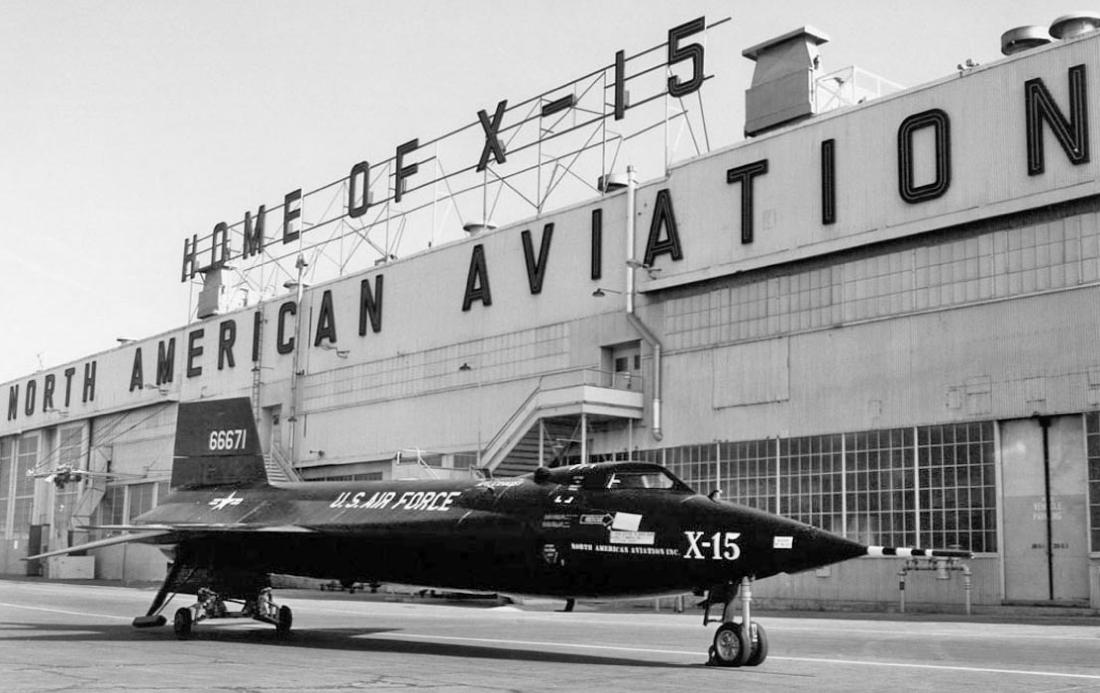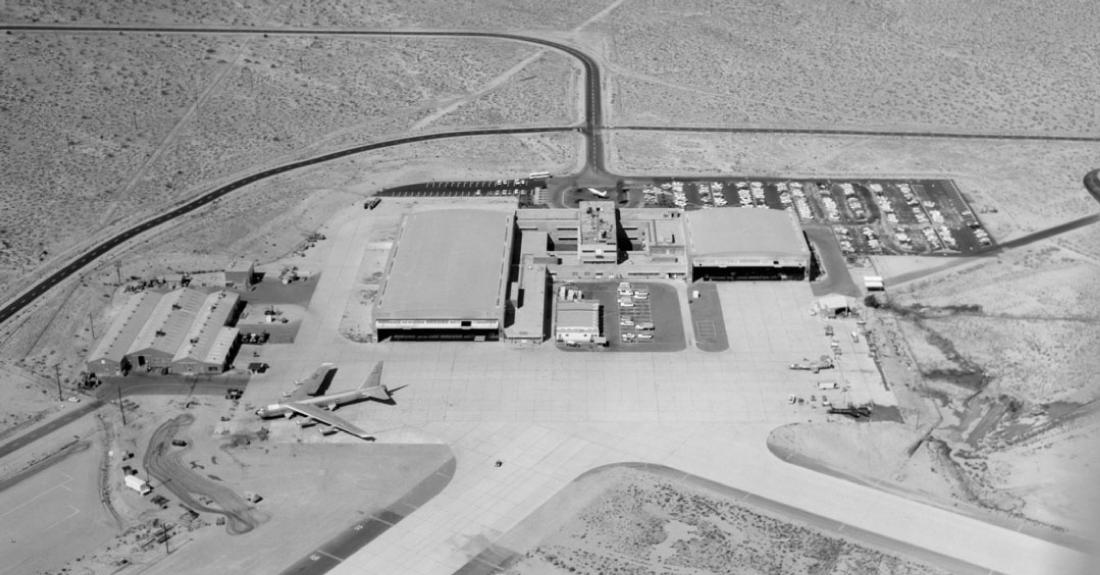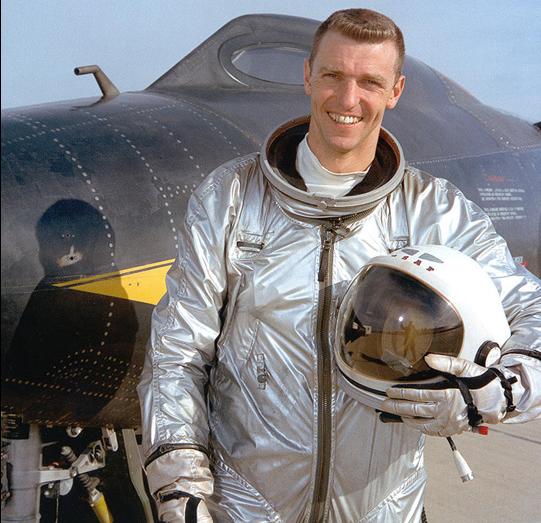


















Celebrating the X-15 Hypersonic Rocket-Powered Aircraft: A Milestone in Aviation History
The X-15 hypersonic rocket-powered aircraft, constructed by North American Aviation (NAA), played a pivotal role in advancing our understanding of flight at speeds exceeding Mach 6 and altitudes above 250,000 feet. This groundbreaking project was a collaboration among NASA, the U.S. Air Force, and the U.S. Navy. The X-15’s first powered flight took place on September 17, 1959, at the Flight Research Center, now known as the Armstrong Flight Research Center, located at Edwards Air Force Base in California. The pilot for this historic flight was NAA’s chief test pilot, A. Scott Crossfield, who also conducted several early test flights before NASA and the Air Force took over the aircraft. From 1959 to 1968, 12 pilots completed 199 missions, achieving higher speeds and altitudes that would later influence the development of future programs such as the space shuttle.


Caption: Left: During its October 1958 rollout ceremony at the North American Aviation (NAA) facility in Los Angeles, NAA pilot A. Scott Crossfield poses in front of the X-15-1. Right: Rollout of X-15-2 at the NAA facility in February 1959.
The Origins of the X-15
The inception of the X-15 dates back to 1952 when the Committee on Aerodynamics of the National Advisory Committee for Aeronautics (NACA) adopted a resolution to expand their research to study flight at altitudes between 12 and 50 miles and Mach numbers between 4 and 10. The U.S. Air Force and Navy agreed to this initiative and conducted joint feasibility studies at NACA’s field centers. In 1955, the Air Force selected North American Aviation in Los Angeles to construct three X-15 hypersonic aircraft.
On October 1, 1958, the newly formed National Aeronautics and Space Administration (NASA) incorporated the NACA centers and inherited the X-15 project. Just two weeks later, on October 15, 1958, the first of the three aircraft was rolled out at NAA’s Los Angeles facility. Several early X-15 pilots, including Crossfield, attended the ceremony. Following the event, workers wrapped the aircraft, placed it on a flatbed truck, and transported it overnight to the High Speed Flight Station, which NASA renamed the Flight Research Center in September 1959. This location would be the site for all X-15 flights. Before the first aircraft took to the skies, NAA rolled out X-15-2 on February 27, 1959, and the X-15-3 completed the fleet in early 1960.

Caption: Aerial view of the Flight Research Center, now NASA’s Armstrong Flight Research Center, at Edwards Air Force Base, California, with one of the B-52 carrier aircraft at left and an X-15 at right. Image credit: courtesy JD Barnes Collection.


Caption: Left: Diagram showing the two main profiles used by the X-15, either for altitude or speed. Right: The twin XLR-11 engines, left, and the more powerful XLR-99 engine used to power the X-15.
Flight Operations and Technical Specifications
Similar to earlier X-planes, a carrier aircraft, specifically a modified B-52 Stratofortress, released the 34,000-pound X-15 at an altitude of 45,000 feet to conserve its fuel for the research mission. These flights took place within the High Range, a flight corridor extending from Wendover Air Force Base in Utah to the Rogers Dry Lake landing zone adjacent to Edwards Air Force Base, with emergency landing zones along the route. Typical research missions lasted between eight to 12 minutes and followed either a high-altitude or high-speed profile after launch from the B-52 and ignition of the X-15’s rocket engine. After the engine burned out, the pilot guided the aircraft to an unpowered landing on the lakebed runway.
To withstand the high temperatures experienced during hypersonic flight and reentry, the X-15’s outer skin was made of a nickel-chrome alloy called Inconel-X. Traditional aerodynamic surfaces used for flight control within the atmosphere do not function in the near-vacuum of space, so the X-15 utilized its Ballistic Control System thrusters for attitude control while flying outside the atmosphere.
Initially, the X-15 was equipped with eight smaller XLR-11 engines producing only 16,000 pounds of thrust due to delays in the development of the XLR-99 rocket engine, which was specifically designed for the X-15 and capable of producing 57,000 pounds of thrust. Consequently, the X-15 remained significantly underpowered during the first 17 months of test flights. NAA chief pilot Crossfield was primarily responsible for conducting the initial test flights before the aircraft was handed over to NASA and the Air Force.


Caption: Left: Flight profile of the first unpowered glide test flight of the X-15. Right: A. Scott Crossfield pilots the X-15 during its first unpowered glide test flight in June 1959.
With Crossfield at the controls of X-15-1, the first captive flight, during which the X-15 remained attached to the B-52’s wing, took place on March 10, 1959. Crossfield completed the first unpowered glide flight of X-15-1 on June 8, the flight lasting just five minutes.


Caption: Left: The B-52 carrier aircraft taxis on the runway at Edwards Air Force Base in California, with the X-15 and pilot A. Scott Crossfield ready to perform the first powered flight of the hypersonic research aircraft. Right: The B-52 carries the X-15 and Crossfield to the drop altitude.


Caption: Left: Pilot A. Scott Crossfield is visible in the cockpit of the X-15 shortly before the release from the B-52 carrier aircraft. Image credit: courtesy North American Aviation. Right: The X-15 dumps excess fuel just prior to the drop.



Caption: Left: The X-15 drops from the B-52 carrier aircraft to begin its first powered flight. Middle: The view from the B-52 as the X-15 drops away. Right: Pilot A. Scott Crossfield has ignited all eight of the X-15’s engines to begin the powered flight.
The First Powered Flight and Subsequent Achievements
On September 17, with Crossfield at the controls of X-15-2, the first powered flight of an X-15 was completed. By firing all eight of the XLR-11 engines for 224 seconds, Crossfield achieved a speed of Mach 2.11, equivalent to 1,393 miles per hour, and reached an altitude of 52,341 feet. Despite encountering a few hardware issues, Crossfield successfully landed the aircraft after a flight lasting just over nine minutes and covering a distance of 88 miles. Throughout 12 more flights, Crossfield expanded the aircraft’s flight envelope to Mach 2.97 and 88,116 feet while collecting valuable data on its flying characteristics. His last three flights utilized the higher thrust XLR-99 engine, which was specifically designed for the X-15. Crossfield’s 14th flight on December 6, 1960, marked the end of the contracted testing program, after which North American handed over the X-15 to the Air Force and NASA.

Caption: Standing between the first two aircraft, North American Aviation chief test pilot A. Scott Crossfield, left, symbolically hands over the keys to the X-15 to U.S. Air Force pilot Robert M. White and NASA pilot Neil A. Armstrong at the conclusion of the contracted flight test program. Image credit: courtesy North American Aviation.
The Legacy of the X-15 Program
Over nine years, Crossfield and 11 other pilots – five from NASA, five from the U.S. Air Force, and one from the U.S. Navy – completed a total of 199 flights of the X-15, gathering data on the aerodynamic and thermal performance of the aircraft as it flew to the edge of space and returned to Earth. The pilots also conducted numerous experiments, leveraging the aircraft’s unique characteristics and flight environment. NASA chief pilot Joseph “Joe” A. Walker flew the first of his 25 flights in March 1960. On his final flight on August 22, 1963, Walker took X-15-3 to an altitude of 354,200 feet, or 67.1 miles, the highest achieved in the X-15 program, a record for piloted aircraft that stood until surpassed during the final flight of SpaceShipOne on October 4, 2004.




Caption: Left: Chief NASA X-15 pilot Joseph “Joe” A. Walker following his altitude record-setting flight in August 1963. Middle left: Air Force pilot William J. “Pete” Knight following his speed record-setting flight in October 1967. Middle right: NASA pilot Neil A. Armstrong stands next to an X-15. Right: Air Force pilot Joe H. Engle following a flight aboard X-15A-2 in December 1965.
On October 3, 1967, Air Force pilot William J. “Pete” Knight flew X-15A-2, with fully fueled external tanks, to an unofficial speed record for a piloted winged vehicle of Mach 6.70, or 4,520 miles per hour. This record stood until surpassed during the reentry of space shuttle Columbia on April 14, 1981. NASA pilot Neil A. Armstrong and Air Force pilot Joe H. Engle also flew the X-15 before joining NASA’s astronaut corps. Armstrong flew the X-15 seven times before becoming an astronaut, where he participated in the Gemini VIII mission in 1966 and took humanity’s first steps on the Moon in July 1969. Engle uniquely flew both the X-15 (16 times) and the space shuttle (twice in the atmosphere and twice in space). Reflecting on the first powered X-15 flight, Engle remarked that it was “a real milestone in a program that we still benefit from today.”
For more detailed information and the original article, visit NASA’s official website here.

































